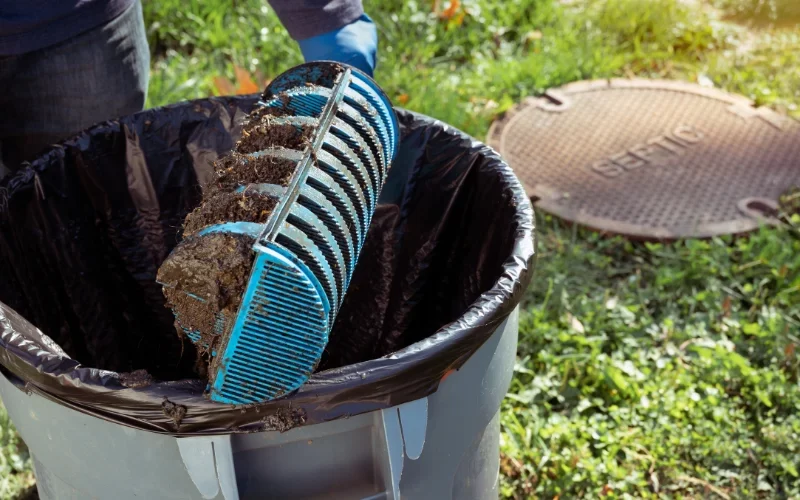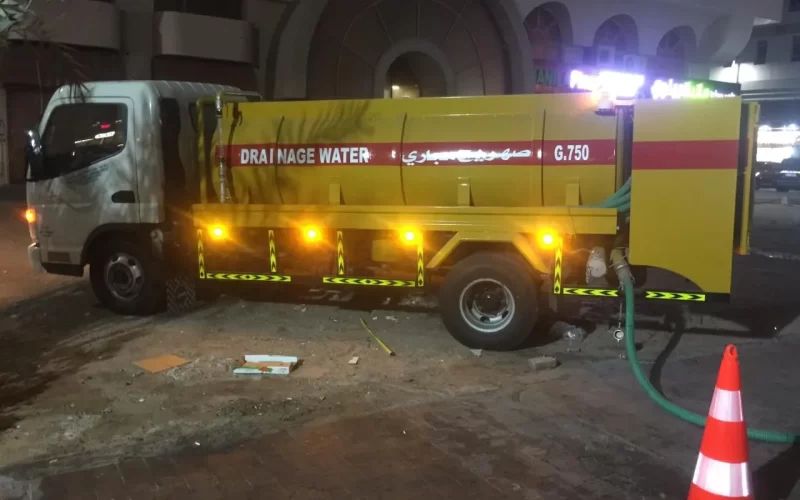- 04-254-5445 / TOLL FREE - 800 (BLUE) 2583
- Info@bluediamondfm.com
Septic tank cleaning is an integral component of maintaining an effective wastewater system. Without regular inspection and cleaning, septic tanks can become clogged with sediment, leading to backups, flooding and untreated wastewater released back into the environment.
A septic tank is an underground, watertight container that collects and treats household wastewater through a natural biological process. It’s an essential component of your property’s septic system, which also includes a drain field (also known as a leach field or soil absorption field) where the treated water is dispersed safely into the soil.
Homeowners should consider hiring a service that provides both septic tank cleaning and other related services such as plumbing, maintenance, or inspections and this combination typically saves alot money.
Understanding how your septic system works and prioritizing regular cleaning is key to preventing costly backups, overflows, and potential environmental contamination.
So, let’s dive into the ultimate guide to septic tank cleaning and maintenance!
If you are using either a large commercial facility or small home, every septic system requires regular inspection and cleaning. The frequency of cleaning depends on its size and design as well as intake amount, type of organic matter present in its waste stream and absorption field infrastructure requirements.
Septic tanks are more than just large containers but it serve as treatment plants. After an initial flush, waste enters the tank where bacteria break it down into sludge and lighter waste like fats and grease float to the surface as scum before being pumped out through an absorption field distribution box where it’s evenly spread throughout each trench in the drain field area.
Many modern septic systems use plastic tanks with distribution boxes instead of gravel beds, allowing for greater storage capacity and an evener distribution across trenches. But just like their older counterparts, these tanks still must be periodically inspected and pumped out.
Grease traps must be regularly emptied and cleaned to prevent bio-mat from building up and leading to drain clogs or costly repairs. Hiring a professional Charlotte grease trap cleaner can ensure compliance with health code regulations, keeping your business operating at full steam ahead.

As a general guideline, it’s recommended to have your septic tank inspected and cleaned by professionals every 2-3 years.
However, the frequency may vary based on several factors:
1 Household size:
The more people living in your home, the more wastewater your system has to handle, potentially requiring more frequent cleaning.
2 Water usage:
High-efficiency fixtures and appliances can reduce the amount of water entering the septic system, extending the time between cleanings.
3 Tank size:
Larger tanks have a greater capacity to handle wastewater and solids, allowing for longer intervals between cleanings.
4 Garbage disposal usage:
Excessive food waste can accelerate the accumulation of solids in the tank, necessitating more frequent cleaning.
It’s crucial to watch for warning signs that your septic tank needs attention, such as:
1. Slow draining sinks and toilets
2. Gurgling sounds from plumbing fixtures
3. Sewage odors around the septic tank or drain field
4. Lush, green grass over the drain field (indicating a potential leak or overflow)
If you notice any of these red flags, don’t ignore them and it’s time to call in the professionals for an inspection and potential cleaning.

Here’s a step-by-step breakdown of the septic tank cleaning process:
1 Locating and accessing the tank:
The service technicians will locate the septic tank lid and remove it, providing access to the tank’s interior.
2 Inspecting the tank:
Before cleaning, we will conduct a thorough inspection of the tank’s condition, checking for cracks, leaks, or any signs of damage that may require repairs or tank replacement.
3 Pumping and cleaning:
Using specialized vacuum trucks and hoses, our technicians will remove the accumulated sludge and scum layers from the tank. This process may involve agitating the contents to break up compacted solids, ensuring a thorough cleaning.
4 Bacterial additive (optional):
In some cases, the professionals may recommend adding a bacterial additive to the tank after cleaning. These products can help re-establish the beneficial bacteria necessary for the septic system’s biological treatment process.
5 Final inspection:
Before closing up the tank, the technicians will perform a final inspection, checking for any remaining issues or concerns that need to be addressed.
The entire cleaning process typically takes 1-2 hours for an average residential septic tank. Costs can vary based on factors like tank size, accessibility, and the amount of waste that needs to be removed for a standard cleaning service.
During the cleaning process, it’s crucial not to damage or excessively disrupt the bacterial ecosystem within the septic tank. These microorganisms play a vital role in breaking down and treating the wastewater, so preserving their population is essential for the proper functioning of your septic system.
While many people have conflict between “septic pumping” and “septic tank cleaning”, these are two distinct services. Pumping removes liquid waste from your septic tank while cleaning involves thoroughly clearing away solid materials that accumulate at the bottom of it. Both services should be regularly performed for your own good and to ensure smooth functioning of your system.
Professional septic tank pumpers first need to locate your tank by digging through some of the surrounding soil until they discover it. Once located, they open up its lid and begin extracting waste through a hose connected to a truck; they then transport this material for disposal at specific location.
An improperly functioning septic tank can release dangerous materials into the drain field and endanger water sources as well as cause health concerns for residents living nearby. Regular inspection and cleaning can prevent this from occurring.
At Blue Diamond Group, we provide septic tank inspection, if it is residential or commercial property, having an effective septic system is key to savings on utility bills and keeping wastewater out of the environment but only when properly maintained.
Regular tank inspection and cleaning helps avoid solid materials accumulating within its depths that could cause costly repairs and health hazards in future.
Septic tank cleaning involves using a truck fitted with vacuum equipment to vacuum the contents of a septic tank. In order to do this, we must locate and excavate enough soil around it in order to uncover its lid, once exposed, we use a hose reroute to remove all liquids and sludge before pumping it away from your house.
As part of our septic tank cleaning service, our technicians will also inspect it for any physical damage that has occurred and ensure all filters and baffles are functioning as intended. Otherwise, waste could be transported too rapidly through to drain field systems.
Drain field lines require regular inspection and cleaning as they serve to transport wastewater to a septic tank, and can become clogged up with materials that cannot be broken down by natural bacteria in a septic system.
To keep your septic tank clean, follow these simple steps:
1 Avoid flushing non-biodegradable items like diapers, wipes, and grease down the drain.
2 Fix leaks, install water-saving fixtures, and spread out water usage to prevent overloading the system.
3.Use septic-safe cleaning products and avoid pouring harsh chemicals down the drain.
4.Don’t Park heavy vehicles on the drain field it can damage pipes, affecting the tank’s efficiency.
The recommended frequency varies, but we suggest cleaning your septic tank every 2-5 years, depending on factors like tank size and household usage.
While it’s possible to attempt DIY septic tank cleaning, it’s not recommended due to the potential health hazards, environmental risks, and the specialized equipment and knowledge required.
The duration can vary depending on the size of your tank and the amount of waste to be removed, but most standard cleanings take between 1-3 hours.
Yes, signs like slow draining fixtures, gurgling sounds, foul odors, and lush green grass over the septic tank area can all indicate that your tank needs to be cleaned.
Yes! We offer comprehensive services, including repairs, inspections, and ongoing maintenance in addition to cleaning.
Conclusion
Regular septic tank cleaning and maintenance are essential for homeowners with septic systems. By following the guidelines outlined in this guide, you can ensure that your system operates efficiently, minimize the risk of backups and overflows, and protect the surrounding environment from contamination.
Don’t wait until it’s too late, schedule professional septic tank cleaning services every 2-3 years and practice good maintenance habits in between.
If you’re in need of septic tank cleaning services or have concerns about the condition of your septic system, don’t hesitate to reach out to our team of professionals. We’re here to help you keep your septic system running smoothly.
Blue Diamond Group Is Recognized as a Leading Facilities Service Provider in UNITED ARAB EMIRATES.
Head Office: MJM Al Ansari Building, Port Saeed, Deira, Dubai.
Blue Diamond Group 2024All Rights Are Reserved.
ISO CERTIFIED COMPANY 9001, 14001, 45001, 41001.
Get in touch with us